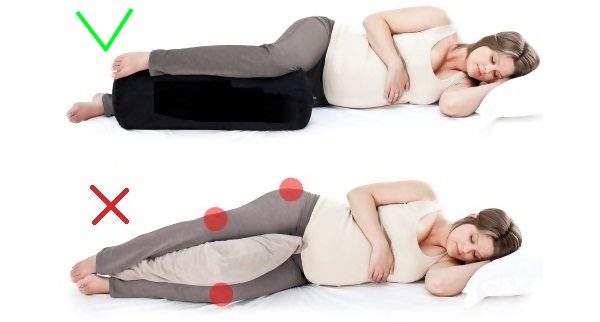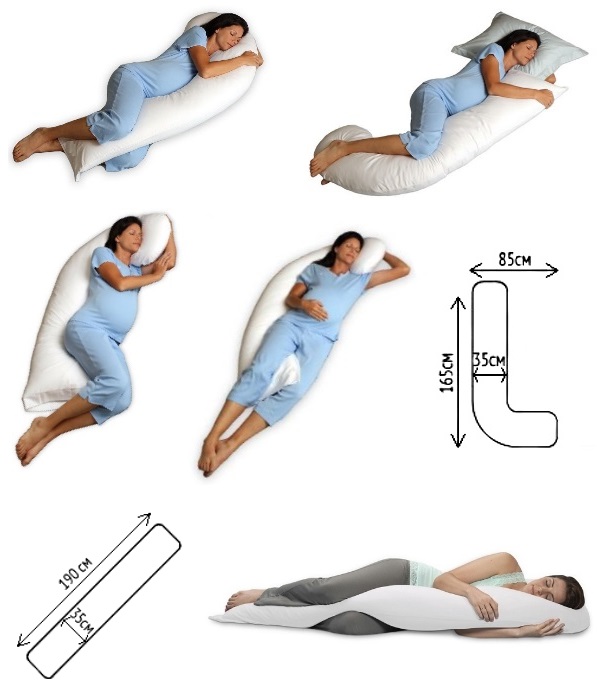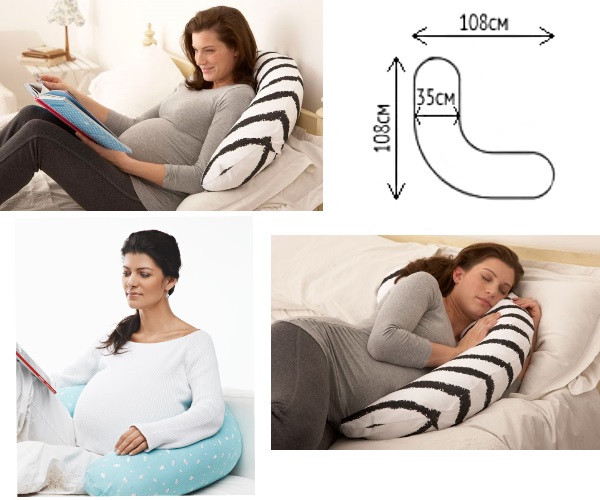Adequate sleep during pregnancy is the key to the well-being of the expectant mother, and therefore the child. But how do you need to sleep during pregnancy in order to feel cheerful after waking up, and not to suffer from aches and numbness of certain parts of the body.
1 trimester. On the early dates while the fetus is still very small, the woman can sleep in any comfortable position... You can sleep on your stomach only for the first 11 weeks of bearing a baby, because in the first trimester the uterus is protected from compression by the pubic and pelvic bones, and bladder takes all the blows and pressure. The only thing that can bring discomfort to a pregnant woman is soreness and tenderness of the breasts. That is why many women give up their favorite sleeping position already from the beginning of the first trimester of pregnancy.
2 trimester. By the twelfth week, the uterus begins to go beyond the boundaries of the pubic articulation, and although the fetus is reliably protected from external pressure by adipose tissue, the uterine wall and amniotic fluid, but still starting from the second trimester sleeping on your stomach is not advisable.
Digestive problems
Pregnant women already have a lot of worries and still find it difficult to sleep. Forcing a pregnant woman to become aware of her situation will not make her sleep easier. By consciously trying to control your sleeping position, you can fall asleep and sleep even more, preventing you from sleeping well.
If you have trouble sleeping during pregnancy, here are guidelines for a good night's sleep. Use pillows to ease the weight of the uterus, especially in the latter part of pregnancy. Try not to rest or sleep too much during the day. Exercise regularly, but not late at night or late at night. Do not eat heavy or spicy food before bedtime. Eat 3-4 hours before bed. You can eat a small snack if you are hungry before bed. Don't drink too much in the afternoon and empty your bladder shortly before you fall asleep. Sleep at a comfortable temperature. Your mother was right: drinking a cup of hot milk before bed will ease your sleep and give you the calcium you need. And if that doesn't work, try the latest sleep and relaxation technique: the bedtime orgasm.
- Find a position that is comfortable for you.
- It could be on your side or back.
- Don't force yourself into one position.
- Take a warm bath or shower before bed.
From 25-28 weeks of pregnancy, when the fetus begins to actively grow, you should not sleep on your back, because such a sleeping position can cause:
- deterioration of blood circulation in the placenta, as a result of which the fetus may suffer from oxygen starvation (hypoxia);
- the development of hemorrhoids in the expectant mother, venous stasis and edema in the lower extremities, varicose veins and even thrombophlebitis;
- aching back pain;
- lowering blood pressure, and as a result of the appearance of dizziness, weakness, darkening in the eyes, tinnitus, rapid breathing, severe sweating, nausea (possibly even vomiting);
- the appearance of problems with digestion (since the uterus will squeeze the intestines and its large blood vessels);
- disruption of the kidneys and heart.
The complications described above occur due to the fact that when sleeping on the back, the enlarged uterus is pressed against the spine, squeezing the inferior vena cava and aorta (see Figure 1). Compression of the inferior vena cava, which carries blood from the lower extremities up to the heart, causes a decrease in the return of venous blood to the heart, and a woman's arterial pressure decreases, the blood in the veins stagnates, and uterine and renal blood flow decreases.
Sleeping and finding the right sleeping position are real challenges when women lose sleep right through their pregnancies, especially in the last trimester. Lying on your back may seem comfortable, but did you know it can negatively affect your child? Is sleeping on your back good or bad for you and your baby?
What happens when you sleep on your back?
While this is truly an innocent thing for pregnant women, it can cause problems when you reach your last stage of pregnancy. In this position, the weight of the growing uterus and baby is pressed against the mother's lower genital cavity, the vein that carries deoxygenated blood to your heart from the lower body. When this happens, blood to the heart slows down at a rate, thereby reducing blood flow to the baby, so it receives less nutrients and oxygen.

Figure 1 - Demonstration picture of why you need to sleep on your side during pregnancy
You can put a large pillow under your back, which, when changing position, will prevent the woman from lying on her back.
The sleeping position is so individual that it will be more comfortable for some to sleep on the right side, for others the baby will signal with kicks that it is uncomfortable for him to be in this position, and then it is better to roll over on the other side.
According to a study published in the British Medical Journal, there is a link between the sleeping position of the mother and stillborn babies. Pregnant women who slept on their backs or on the right were doubly at risk of stillbirths compared to those who slept on the left side. The risks of this, although small, instruct women to sleep on the left side as much as possible for safety.
How do your sleeping positions affect your child?
Although not early in your pregnancy, as it progresses, sleep may come at a premium. Your large stomach can make it very uncomfortable for you to sleep well, or you may wake up feeling sudden spasms of pain. Inevitably, your sleeping position affects not only you but your baby's growing health as well. You cannot sleep at an uncomfortable angle one night, as this can cause problems for your baby, but you also cannot sleep on your stomach or right side, as this will increase your chances of miscarriage.
3 trimester. During this period, it is recommended sleep exclusively on the left side, because lying on the right side, the grown baby squeezes the liver and the right kidney of the woman, which is located slightly lower than the left one. Pinching the ureter of the kidney leads to stagnation of urine, as a result of which a disease such as pyelonephritis can develop.
Let's take a close look at how women should sleep during their three trimesters. You may be comfortable and comfortable sleeping on your stomach during the early days of pregnancy. However, as the pregnancy progresses, it will become detrimental to your baby's growth and development, plus you will feel increasing discomfort in this position. In general, in your first trimester, you don't need to worry about your sleeping position.
Is it possible for pregnant women to sleep on their backs and on their stomachs - the optimal position for good rest
As you enter your second trimester, experts advise you to stop sleeping on your back, but switch to sleeping on one side. This is because you get back pain from sleeping on your back. Sleeping in this position can also cause you breathing problems, digestive problems and low blood pressure, and possibly hemorrhoids.
For a more comfortable sleep, it is recommended to put a pillow between the legs, while stretching the left leg, and bending the right at the knee (see Figure 2). So the legs will not flow, and the load on the pelvis will be less. You can also place a small pillow under your belly.

Heartburn is another reason why you shouldn't sleep on your back. In this trimester, the uterus expands and the diaphragm narrows, making breathing difficult, and the esophagus and intestines are pulled out of the joint, causing reflux and heartburn when you sleep on your back. Doctors do not protect pregnant women in their three trimesters to sleep on their backs. You are obviously big this trimester, so when you sleep on your back, your uterus, which is heavy right now, can restrict blood flow to the uterus and your growing fetus. You won't find sleeping on your back comfortable anyway, so it's best to sleep by your side.
Figure 2 - Photo of the correct body position during sleep
It is also recommended to sleep on the left side if the fetus is in the wrong position. With a transverse presentation of the fetus, sleep on the side where its head is displaced. It is also useful to do the following exercise: lie on one side for about 5-10 minutes, then roll over on the other side for 5-10 minutes. Perform on an empty stomach for 1 hour 2-3 times a day.
In this position, your fetus grows better and is in excellent condition. In addition, blood flow to the placenta is reduced because the weight of the uterus compresses the inferior vena cava. On both sides, the left side is the best choice, since the uterus rotates to the right side during pregnancy, and sleep on the left centers is more and increases blood flow.
Sleeping in the abdomen, back or lateral position - what is the best sleeping position during pregnancy and can a pregnant woman sleep on her stomach? At the beginning of pregnancy, women can still sleep at your convenience. But over time and further, the belly will soon become a taboo, because it becomes increasingly difficult for a pregnant woman to sleep on a constantly thickening belly. But as long as pregnant women do not feel any pressure, the prone position does not harm their baby. For most pregnant women, the sleeping position is abdominal cavity unpleasant from the week to the week of pregnancy, but some may sleep longer in the abdomen, which differs from woman to woman.
With the pelvic position of the fetus, it is useful to sleep on the left side and regularly perform the following exercise: lie on a hard, flat surface, placing a pillow under the buttocks, folded in half so that the pelvis rises above the level of the head by 20-30 cm.Stay in this position for about 5 minutes (but not more than 15 minutes). We take this position 2 times a day for 2-3 weeks starting from 32 weeks (not earlier).
And as soon as the baby accepts correct position, it is necessary to start wearing a bandage regularly (with prolonged stay on your feet).
Can a pregnant woman sleep on her stomach? To lie on their backs, many pregnant women also feel uncomfortable. The back of the thigh becomes thicker and heavier, and the back of the uterus contracts in some women, which can lead to low blood pressure, dizziness and nausea. In addition, the pressure is placed on certain organs due to the supine position, causing an increased urge to urinate. Doctors and midwives advise mothers about a week about their backs, because otherwise they will lie on the floor and therefore cannot be properly cared for.
If a pregnant woman often has heartburn, nasal congestion, difficulty breathing, then you should sleep so that the upper body is raised.
In case of varicose veins, edema and leg cramps, it is recommended to place a pillow under the feet during rest so that the blood flows better from the lower extremities.
Better sleeping position during pregnancy
The best position for pregnant women is the lateral position. If you wake up at night and lie on your back or stomach, this is not a problem. Just lie on the page. This is very useful and convenient if you are pinching the pillow under your belly and between your legs. But all of a sudden, from one night to the next, it just didn't work anymore. On the advice of my doctor, we have arranged a new mattress. This improved the situation significantly within a few weeks.
By the end, things got worse and worse, but apparently there were many other reasons. It is also written like this 😅 In other words, 😉. The wrong week ago must be the right one. The reason, however, is completely wrong! The reason to avoid supine position is vein compression syndrome. “The tension of the baby on the vena cava, which runs behind the uterus, limits venous return to the heart; This applies to circulatory problems up to shock and unconsciousness. " The way it is.
It is impossible to control the position of your body during sleep, therefore for the expectant mother an indispensable assistant in this matter will be a pillow for pregnant women, which, after the baby is born, can help the mother to take a comfortable position during feeding.
What pillow is best to sleep on during pregnancy?
There are many options for pillows on sale, but during pregnancy, a woman needs a special version of this bedding, because during this period the anatomy of her body changes. Therefore, a special pillow for pregnant women has been developed.
Complete irritation overload is a bit like searching for shoes on the Internet. On the one hand, there is such a roll with essential oils against malaise and small acupressure bracelets against the famous morning sickness. My midwife recommended this to me essential oil to buy at the pharmacy.
Try tossing or pulling the pillow between your legs on the left side. You can also buy a maternity pillow, but your normal head pillow is just as good. For added comfort and support, distribute pillows between your legs, under your belly, and behind your back. It also helps relieve tension from the muscles around the thighs and pelvis.
Disadvantages of such a pillow:
- can take up a lot of space on the bed (with small dimensions of the bed, the next sleeping person will be uncomfortable to sleep);
- it is hot in summer, because fillers keep warm and do not absorb moisture released by the body;
- it is necessary to be washed in a dry cleaner (if the pillow does not fit into the machine);
- capable of electrifying;
- the filler made of polystyrene balls rustles.
Material. Hollofiber ball- siliconized balls that look like curls of sheep's wool.
A small study also found that pregnant women who slept on the left were rarely stillborn than women who slept in a different position during pregnancy. If you find yourself on the side, there is too much pressure on your hip. Buy yourself a piece of foam for more comfort and ventilation and place it on the mattress under the sheet. They are in different sizes and strengths in large department stores.
Midwives are advised to use a corset to support the upper leg in a lateral position. Don't forget to download our free app to get interesting information about your pregnancy every day. My Baby Today gives you all the expert answers you need - always ready to go!
Holofiber quickly restores its shape, resistant to washing and creasing. It is soft to sleep on products made from it, they are environmentally friendly and hypoallergenic, mites in such material do not start, and sweat and odors are not absorbed. The material lends itself to machine and hand wash at a temperature not exceeding 40 ° C, you can dry the product in a centrifuge.
Styrofoam balls (or granules)- environmentally friendly durable material resembling foam balls. The toughest filler compared to other synthetic materials.
These balls cannot be washed in the washing machine.
Back pain during pregnancy affects every woman at some point. Women who report early midwife are fortunate enough to learn the most important tricks early on and often even avoid annoying pain. This results in an extreme empty cross, the abdomen is pushed forward and strong traction is observed in the lower back. Just keep the pool conscious. Make your back long and get it. Back up the back - with a cow cat This is an enjoyable and simple exercise from yoga: you go on all fours and alternate between the hump and then the extreme hollow cross. Do the exercise rather slowly and with smooth transitions! A highly recommended exercise because it is very enjoyable and suitable for a cow cat is the diagonal stretch. To do this, you stay on all fours and simultaneously stretch left hand and the right leg diagonally upward, pointing outward. Stretch your back as much as you can. Repeat everything about 10 times per page. Don't you come to training because the pig's inner dog is too strong? Then go to gym or yoga classes, or swim! helps against back pain and just gets on well. Relax your back. Close your back between two light steps. At least as long as you can still lie on your back without getting dizzy through Vein-Kava syndrome. To do this, you lie on your back and support your lower legs with a thick sofaxissen. Or place them directly on the sofa. The height is correct when your legs are at right angles. It looks like a level - hence the name. Your lumbar spine should lie on the ground. Sometimes this is enough as a simple relaxation exercise. If you need to work your back a little more, just stay on the ladder and place your hands sideways next to you or on your stomach. Then think of the clock painted on your crossbones. At each hour of the numeric keypad, tap the ground. The exercise is especially effective when you are tying your pelvic floor. When you are near, pull your belly towards your belly button, leaving a little off the ground. However, the lower part of the backrest must maintain contact with the ground. At the end of the exercise, you should relax again. Then, as always during pregnancy, slowly stand on your side! Pregnant women can use hot water bottles or cherry stone back cushions. Even a relaxing, warm bath can be extremely beneficial for back pain. "Leaving instead of suffering" means the motto! Still good in the abdomen at first. If the belly then grows and you even have a dream, you can do it well to put on the belly. If your belly is no longer pleasant, it also works great when you're just sitting differently from your chair. You can then rest your hands on the backrest, which is complemented by a pillow, and allows you to simply massage while sitting.
- Carry the baby in you, not from you.
- Do you know that when pregnant women suddenly start to waddle?
- This is because pregnant women fall into the lordosis position.
Swan artificial fluff- a synthetic material with a fibrous structure. Such a filler has the following characteristics: it does not cause allergies, is antibacterial, lightweight and resilient, does not collapse after washing.
Synthetic down can be washed by hand and in a washing machine (at t up to 40 ° C), it dries quickly.
Sintepon it is not usually used in the manufacture of pillows for pregnant women, because it is not suitable for allergy sufferers and asthmatics, because contains glue that can cause coughing fits and other manifestations of these diseases. In addition, this material quickly collapses.
Forms. G-shaped- large pillow. Performs the following roles: supports the head and tummy; does not allow the pregnant woman to roll over on her back; allows you to sit comfortably with your foot on the pillow.

U shape- large pillow in the shape of a horseshoe. It will provide a good sleep, comfortable leisure time and feeding the baby. The U-shaped pillow ensures correct body position during sleep and relieves stress on the pelvis and spine. Even children and husband will like such a pillow, because they just want to lie in an embrace with it.

Form C- a universal pillow model. Designed for both sleeping and feeding the baby. While breastfeeding, she supports the elbows, relieving stress on the shoulder (when feeding while sitting). It is convenient to make feeding and lying down.
The "nest" shape allows you to leave the baby unattended while mom brings clean sliders. By placing your baby in the notch in the middle of the pillow, you will protect him from falling out of bed. Also, the inner semicircle "eski" can be used as an auxiliary support when sitting down crumbs.

L shape and in form I – good options for a small bed. The L-shaped model perfectly replaces the usual head pillow. At the same time, she supports her back well, preventing the woman from rolling over onto her back in a dream.
The I-shape is designed to act as a head cushion and hip support. Can be curled into the desired shape.

V-shaped (crescent or boomerang)- compact version. Despite its small size, it retains the necessary functions of a pillow for pregnant women: it can support the head and tummy, or the back or neck (in the "sitting" or "half-sitting" position), or the pelvis and tummy (when placed between the legs). Indispensable when feeding a baby.

You can purchase these pillows in this online store.
Any of the described pillows, if desired, can be made by hand. To help the needlewoman, the pictures show the sizes of the pillows so that you can make patterns on them.
Holofiber and other fillers can be purchased online. One large pillow will need about 3 kg of holofiber.
Note!
Styrofoam balls are very electrifying, and it is not easy to stuff a pillow with them, everything sticks to the fabric, and there will be a lot of cleaning later.The expanded polystyrene balls shrink over time, and it becomes necessary to fill them up with new granules, the price of which for 50 liters reaches 7 dollars (430 rubles). One large product will need 100-120 liters.
You can buy them on sites that sell frameless bean bags, ottomans and maternity pillows.
The video clearly shows where the inferior vena cava passes, and why you should not sleep on your back in the third trimester of pregnancy.
I wonder if a black cat crosses the road to the crew of astronauts before boarding the spacecraft, the start of the expedition will be postponed? You find it funny? Then think how free you yourself are from such superstitions as "knock on wood" and "spit so as not to jinx it." However, are all folk signs so meaningless?
Popular wisdom is the quintessence of centuries of life experience, and it would be unreasonable to dismiss it, especially in matters of pregnancy. There is an opinion that a woman expecting a baby cannot sleep on her back. Is it true or not? Can pregnant women sleep on their backs?
Throughout life, a person acquires many different habits, and a favorite position in a dream is one of them. Sleeping on your back is a sign of health. This position allows you to relax as much as possible and provide complete rest for the spine and back muscles. At the same time, the nerve endings, heart and abdominal organs experience minimal stress, in addition, after sleep, there are no traces of bruising on the face from the pillow on the back. In general, this sleeping position is a very useful and good habit.
Read also:
- Ectopic pregnancy: causes, signs
Only during pregnancy, women have to give up many habits, including good ones. These include sleeping on your back, however, not from the very first days of pregnancy. You can continue to sleep like this throughout the first trimester, and then the habit will have to be changed. But there are also pitfalls here: it is about the power of habit. It's no secret that we perform many actions absolutely automatically, without even paying attention to them. This also applies to the pose in which we are used to sleeping, so it will take some time to change it. Doctors recommend starting to gradually change sleeping positions from the middle of the second month of pregnancy.
Can pregnant women sleep on their backs in the second trimester?
In the second trimester, the fetus in its development reaches a fairly large size and becomes heavier. An enlargement of the uterus occurs, and it exerts strong pressure on neighboring organs. Especially the kidneys, as well as the intestines and liver, are subjected to pressure. When a woman in the second trimester of pregnancy sleeps on her back, the load is transferred to a greater extent to the area of the spine, where one of the largest veins passes - the hollow veins. It provides blood flow to the lower parts of the body and limbs.
If a hollow venous vessel is squeezed for a long period, which happens during sleep on the back, then the amount of blood flow to the heart will be significantly reduced and a semi-fainting state will ensue:
- breathing is intermittent and frequent;
- feeling of suffocation, lack of air;
- dizziness.
Sleeping on your back during pregnancy is all the more unsafe if a woman has high blood pressure or has sudden changes in blood pressure. At the same time, the baby in the womb experiences a lack of oxygen supplied with blood and a lack of nutrients. Prolonged compressive effect on the vena cava and insufficient blood supply causes the following complications:
- violation of the vital functions of the fetus due to oxygen starvation;
- exfoliation of the placenta from the walls of the uterus, which can be a serious threat to pregnancy;
- defeat of the veins in the legs of a pregnant woman in the form of varicose veins;
- development of hemorrhoids.
The answer to the question is also obvious: is it possible for pregnant women to sleep on their backs in the 3rd trimester. Of course not. For the sake of the normal course of pregnancy, you will have to change your usual lifestyle.
What position should pregnant women sleep in?

How to sleep properly during pregnancy? We will immediately exclude sleeping in the prone position with the stomach down, which is understandable and without explanation. The most acceptable position in this case is sleeping on the left side:
- The pregnant woman needs to lie on her left side with her right arm extended straight in front of her.
- The right leg bent at the knee should be placed on a roller or pillow so that the legs are folded in the shape of the letter P.
Sleeping in this position contributes to:
- improving the blood supply to the fetus and placenta;
- reduction of swelling in a pregnant woman due to the normalization of kidney function;
- relieving pain in the lumbar and lower pelvis;
- reducing the pressure of the uterus on adjacent abdominal organs;
- optimal cardiac activity.
However, in sleep we cannot control our behavior, especially if there is a persistent habit of sleeping on our back. There is no need to be scared when you fell asleep on your side and woke up on your back. This happens spontaneously, and staying in this position for a short time will not harm you or your child.
The body often wakes up on its own if you lie on your back long enough. But getting used to sleeping on the left side is still necessary. Try lying down with your face slightly tilted to the wall. So it will be more difficult for you to roll over onto your back, and the wall will not let you lie down on your stomach. You can also use a pillow placed under your back or hips as a restraint of movement. If sleeping on your left side is causing you discomfort, try half-sitting sleep with a pillow under your left arm and leaning against it.
